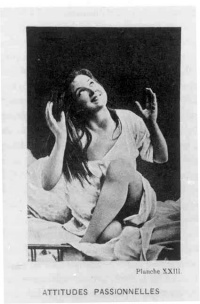Invention of Hysteria
From The Art and Popular Culture Encyclopedia
(Redirected from The Invention of Hysteria)
|
When a woman suffers from hysteria or difficult labour an attack of sneezing is beneficial --Hippocratic Corpus |

Planche XXIII of Attitudes passionnelles, a series of ten photographs first published in the book Iconographie photographique de la Salpêtrière (1875 - 1879). The photo depicts Salpêtrière star patient Louise Augustine.
|
Related e |
|
Featured: |
Invention of Hysteria (1982, French Invention de l’hystérie. Charcot et l’Iconographie photographique de la Salpêtrière is a book by Georges Didi-Huberman on the The Salpêtrière School of Hypnosis, Jean-Martin Charcot, hysteria and the photography found in the three-volume Iconographie photographique de la Salpêtrière.
It featured the photos of Louise Augustine.
[edit]
Product description from the English translation
- "In this classic of French cultural studies, Georges Didi-Huberman traces the intimate and reciprocal relationship between the disciplines of psychiatry and photography in the late nineteenth century. Focusing on the immense photographic output of the Salpetriere hospital, the notorious Parisian asylum for insane and incurable women, Didi-Huberman shows the crucial role played by photography in the invention of the category of hysteria. Under the direction of the medical teacher and clinician Jean-Martin Charcot, the inmates of Salpetriere identified as hysterics were methodically photographed, providing skeptical colleagues with visual proof of hysteria's specific form. These images, many of which appear in this book, provided the materials for the multivolume album Iconographie photographique de la Salpetriere. As Didi-Huberman shows, these photographs were far from simply objective documentation. The subjects were required to portray their hysterical "type"--they performed their own hysteria. Bribed by the special status they enjoyed in the purgatory of experimentation and threatened with transfer back to the inferno of the incurables, the women patiently posed for the photographs and submitted to presentations of hysterical attacks before the crowds that gathered for Charcot's "Tuesday Lectures." Charcot did not stop at voyeuristic observation. Through techniques such as hypnosis, electroshock therapy, and genital manipulation, he instigated the hysterical symptoms in his patients, eventually giving rise to hatred and resistance on their part. Didi-Huberman follows this path from complicity to antipathy in one of Charcot's favorite "cases," that of Augustine, whose image crops up again and again in the Iconographie. Augustine's virtuosic performance of hysteria ultimately became one of self-sacrifice, seen in pictures of ecstasy, crucifixion, and silent cries. "
[edit]
See also
- Etudes cliniques sur la grande hystérie ou hystéro-épilepsie
- Désiré-Magloire Bourneville and Paul Regnard, Iconographie photographique de la Salpêtrière, 1875 - 1879
- Madwoman
Unless indicated otherwise, the text in this article is either based on Wikipedia article "Invention of Hysteria" or another language Wikipedia page thereof used under the terms of the GNU Free Documentation License; or on research by Jahsonic and friends. See Art and Popular Culture's copyright notice.

